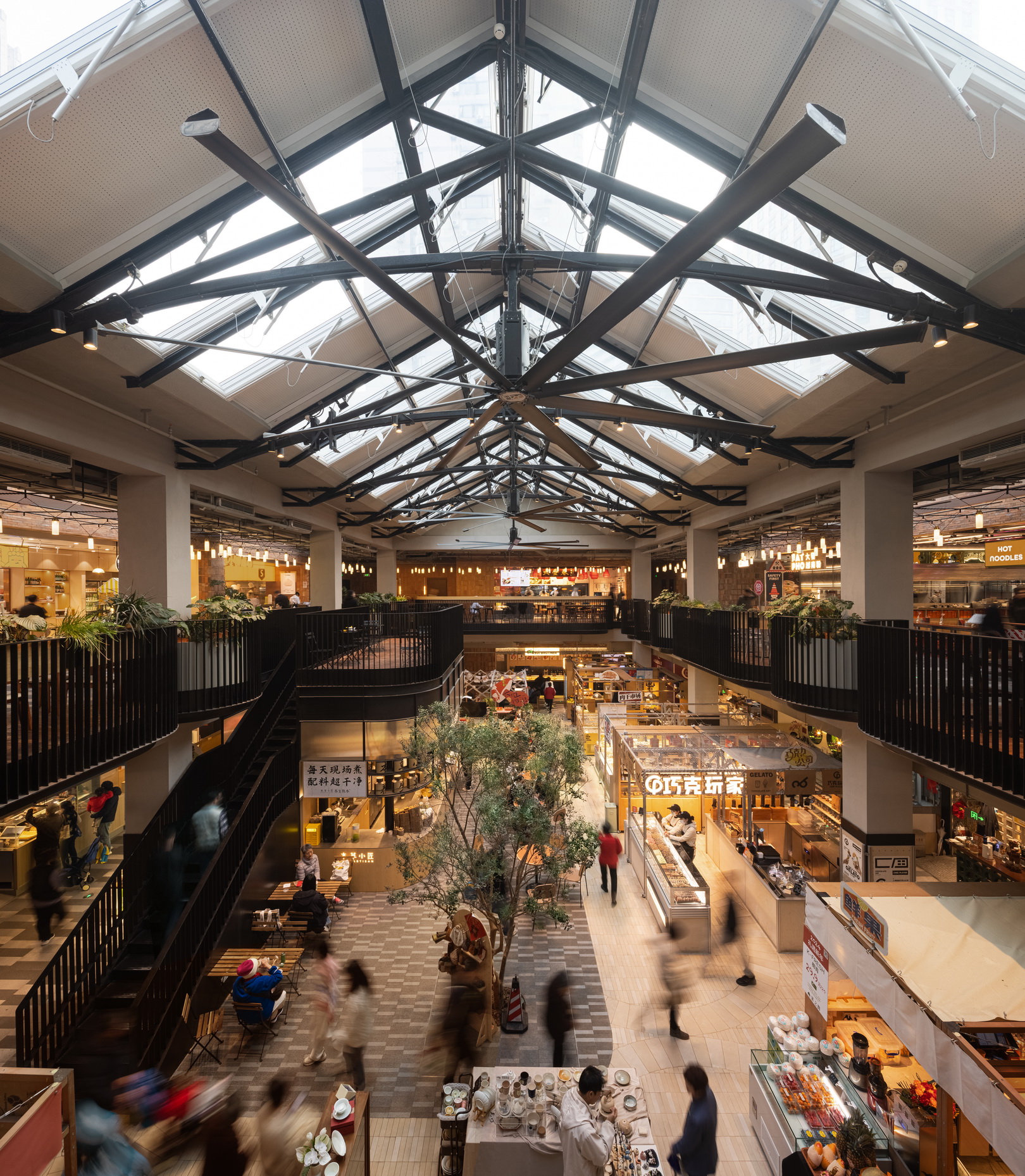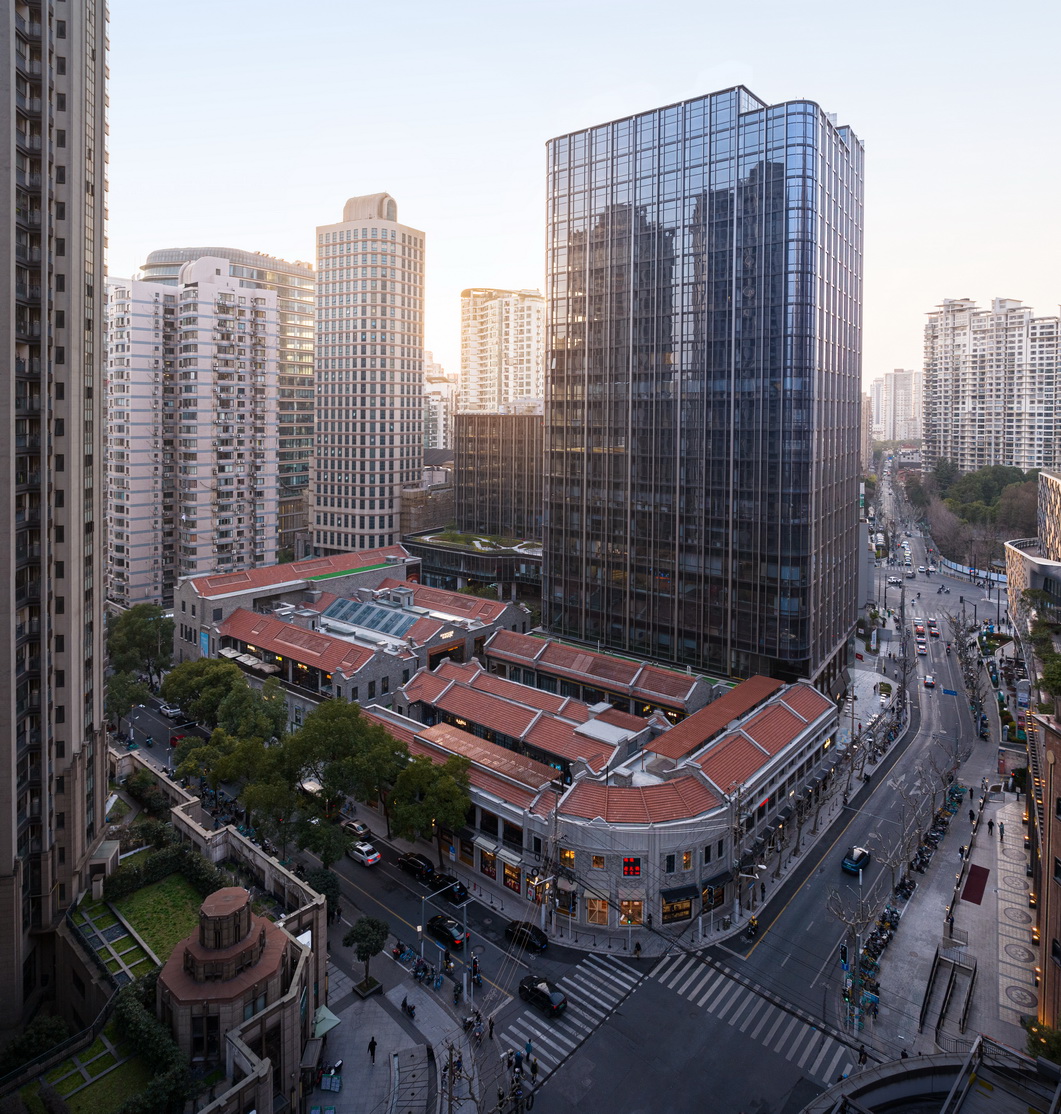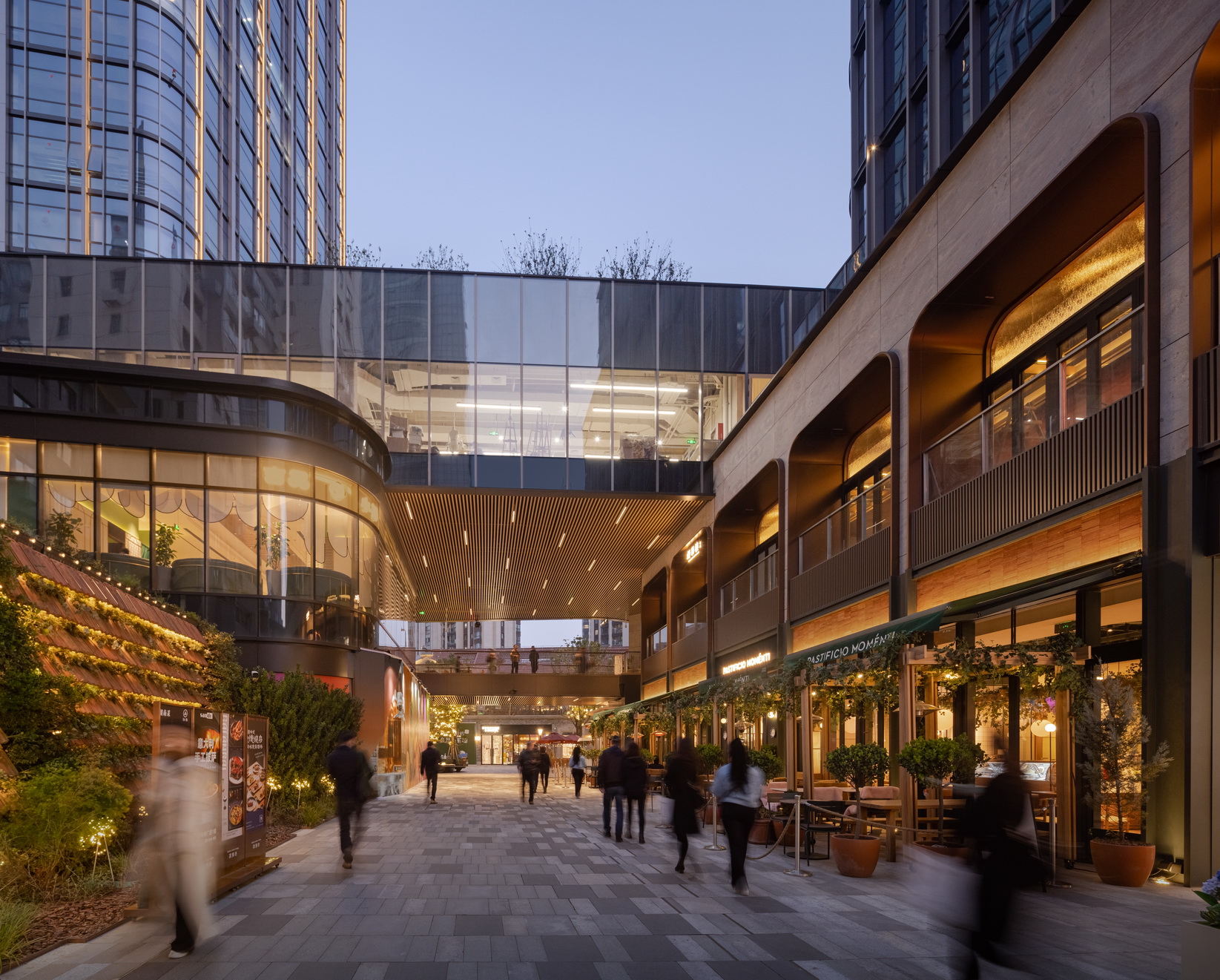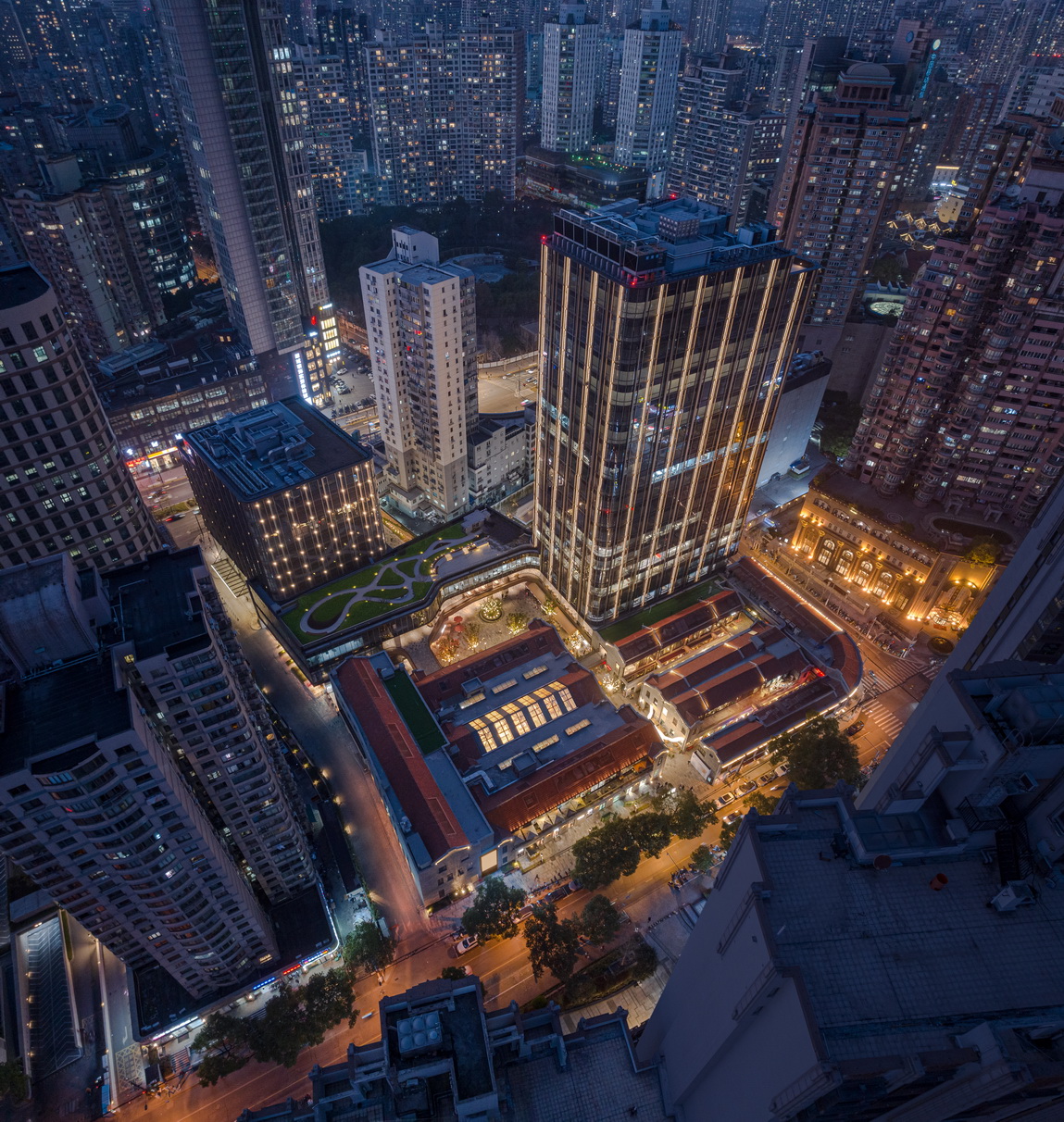“商业空间的城市更新设计,更需要建筑师关注运营规律,同时运用丰富的想象力,在延续历史文脉的基础上,利用新旧之间的碰撞融合,为城市公共空间塑造崭新特质。”
——王彦,goa大象设计总建筑师
鸿寿坊位于上海市普陀区,北邻长寿路,原址是一片始建于1933年,包含多条里弄的石库门住宅。随着里弄建筑逐渐破败老化,地块被纳入城市更新范围内,goa大象设计于2018年受业主委托,承接了这一项目的规划设计工作,将鸿寿坊更新为多功能、高容积率的商业办公综合体。规划方案的总体格局与更新策略延续至项目建成开放。
01 大隐于市的寻常里弄
鸿寿坊所在的长寿路地区是历史悠久的商业中心,20世纪初,该地区集中开发了大量工厂,工人在工厂周边聚居,形成了包括鸿寿坊在内的连片住宅区,服务于产业人口的商铺同步发展,一度使长寿路得到“沪西商业第一街”的美誉,2018年,为高层建筑所环绕的鸿寿坊是经历高强度再开发的长寿路商圈内为数不多尚存的里弄街区之一。然而,规划设计介入时,动迁工程已经启动,大部分建筑均有所残损。作为20世纪初的“经济适用住宅”,鸿寿坊既有的石库门里弄均为一般历史建筑,除部分装饰艺术风格的门头构件外,艺术价值相对有限,但里弄呈现的鱼骨状平面格局与沿街转角处的连续界面,则表现出典型的城市肌理特征。基于历史建筑保护顾问的甄别结果,设计团队采取三种因地制宜的保护方式:原址保护、整体复建与构件再利用。西康路与新会路街角的三栋建筑保存状况较好,因此在进行简单修缮后完整保存;相邻的四栋里弄建筑在测绘后整体复建;其余建筑由于结构受到严重破坏而被拆除,但有价值的石库门构件与建筑材料将被保留,并应用到修缮与复建过程中。
02 记忆的复苏与新生
历史上的石库门里弄是为普通人设计的住宅,并逐渐演化为邻里间生活与交往活动发生的场所。为此,规划设计在前期调研时即希望更多保留里弄建筑亲近生活的近人尺度,探索在当代生活需求指引下的多样化利用方式,形成真实,易感知的独特空间。然而,当不再作为住宅被使用时,里弄建筑如何延续邻里空间的集体认同感?设计团队尝试从空间的原生形态中寻求启发。在动迁开始前,鸿寿坊沿街建筑的一层普遍被作为商铺使用,二层则用于居住。 这一传统可以追溯到鸿寿坊建成的20世纪30年代。
阿尔多·罗西曾在《城市建筑学》中将城市描述为“众多被认同事物的聚合”,与“不同时代和地点的特定生活”相关。对周边的居民乃至上海市民而言,“上宅下铺”的里弄空间利用方式正是一种得到广泛认同的原型。
规划设计希望保留并拓展这种原型,并将其转译为更适合现代生活的形式。沿街“外市”得到保留,容纳富有烟火气的餐饮与零售店铺;同时,商业空间渗透入原本用于居住的“内坊”,里弄内部也成为了人声鼎沸的步行街。基于“里弄”与“市集”两种类型学要素,上位规划中的社区菜场需求成为了规划设计的机遇。设计团队将“里弄”视作一个容器,而“市集”则成为被容纳的功能,两者的碰撞与融合形成了独具匠心的“里弄市集”空间。西侧的三栋里弄建筑内部“掏空”,拆除隔墙,并在建筑间的两条支弄上方加盖玻璃屋顶,三条里弄由此成为了一栋拥有通透开阔空间的商业建筑,容纳菜场与餐饮结合的FOODIE SOCIAL鸿寿坊食集,在建成开放后成为街区中最受欢迎的标志性空间。
03 新旧共生的综合开发
鸿寿坊原有里弄住宅的容积率仅为0.9,但开发规划中所要求的容积率达到4.1,并包括了高层办公、菜场、社区配套、公交整流站与地下车库等多元功能,给规划设计带来挑战。为满足容积率需求,原有里弄建筑拆除后留下的空地规划有两栋高层办公塔楼。设计团队进行反复测算,推敲出合理的高度与位置,以东西错位布局为北侧住宅让出了日照空间。总图规划保存了原有里弄的主支弄关系与鱼骨状肌理,并基于新功能的需求优化巷弄尺度以改善使用者的空间体验。入口和中心广场被打造成开阔的空间节点,作为聚集与交往的公共空间。新建办公塔楼的裙房与复建建筑相贴邻,新旧建筑的对话创造出极富特色的入口门厅形象,令使用者在现代生活的快节奏中触摸到历史的温度。在规划设计阶段,设计团队即考虑到整个生命周期内的资源消耗。保护策略中对旧建筑拆除后的老材料进行复用,以减少能耗和碳足迹。绿化设计在巷弄中植入绿化节点,并延伸到裙房屋顶,改变了石库门里弄高密度、低绿化率的传统面貌,为社区提供触摸自然的窗口。
Urban renewal of commercial spaces demands that architects pay close attention to operational logics while applying abundant imagination. On the basis of continuing historical context, the collision and fusion of old and new must be leveraged to create entirely new qualities for the city’s public realm.
— Wang Yan,Principal, goa
Hongshou Fang is located in Putuo District, Shanghai, immediately north of Changshou Road. The site was originally a 1933 shikumen lilong neighbourhood comprising several lanes. As these lane houses deteriorated, the block was incorporated into the city’s urban-renewal programme. In 2018 the developer commissioned goa to master-plan and design the project, transforming Hongshou Fang into a mixed-use, high-FAR commercial-office complex. The overall layout and renewal strategies devised in the planning phase have been carried through to the project’s completion and opening.
01 A Common Lilong Hidden in the City
The Changshou Road area, where Hongshou Fang sits, has long been a historic commercial centre. In the early twentieth century the district was filled with factories; workers settled nearby, forming contiguous residential quarters—Hongshou Fang among them. Shops serving the industrial population flourished, giving Changshou Road the reputation of “the premier commercial street of western Shanghai.” By 2018, encircled by high-rises, Hongshou Fang was one of the last surviving lilong blocks in an area that had undergone intensive redevelopment. Yet when design work began, relocation was already under way and most buildings were damaged. Built as “economical housing” in the early 1900s, the existing shikumen were classified as ordinary heritage structures. Apart from a few Art-Deco entrance canopies, their artistic value was modest; nevertheless, the fish-bone plan and the continuous street-edge façade embodied classic urban fabric. Based on assessments by heritage consultants, the team adopted three site-specific conservation tactics: in-situ preservation, complete reconstruction, and component reuse. Three corner buildings at the intersection of Xikang Road and Xinhui Road were in good condition and retained after minor repairs; four adjacent lilong houses were surveyed and rebuilt in their entirety; the remainder—too structurally compromised—were demolished, yet valuable shikumen elements and building materials were salvaged and reintegrated in the repair and reconstruction process.
02 The Reawakening and Rebirth of Memory
Historically, shikumen lilongs were housing for ordinary people and gradually evolved into places of daily life and neighbourly interaction. From the outset, the design team sought to preserve the human scale that makes lilong buildings approachable, exploring diversified uses suited to contemporary needs to create authentic and legible spaces. Yet once no longer used as residences, how could these structures sustain the collective identity of neighbourhood life? Inspiration was sought in the original spatial typology. Before relocation, ground floors along the street were almost entirely occupied by shops, while upper floors remained residential—a pattern traceable to the 1930s when Hongshou Fang was built.
Aldo Rossi, in The Architecture of the City, described the city as “an agglomeration of things recognized” and tied to “specific lives lived at different times and places.” For local residents—and Shanghainese more broadly—the living-above-shop lilong configuration is a widely recognized prototype.
The plan therefore preserves and extends this prototype, translating it into forms better suited to modern life. The street-facing “outer market” is retained to accommodate lively restaurants and retail; commercial activity also penetrates the formerly residential “inner lanes,” turning the lanes themselves into bustling pedestrian streets. Drawing on the two typological ingredients of “lilong” and “market,” the district’s programmatic requirement for a neighbourhood food market became an opportunity. The lilong is treated as a vessel, the market as the contained function; their collision and fusion created the ingenious “Lilong Market.” Inside the westernmost three lilong buildings, partition walls were removed to hollow out the interiors; glass roofs were added over the two subsidiary lanes, turning the three lanes into a single airy commercial hall that houses FOODIE SOCIAL at Hongshou Fang—a hybrid fresh-food bazaar and dining venue. Since opening, it has become the most popular landmark in the district.
03 Integrated Development of Old and New
The original lilong housing had a floor-area ratio of only 0.9; the renewal programme required 4.1 FAR and had to accommodate high-rise offices, a fresh-food market, community facilities, a bus rectifier station and underground parking—a formidable challenge. To meet the FAR requirement, two high-rise office towers were planned on the footprint of demolished lilong buildings. After iterative studies, the team determined appropriate heights and positions: an east-west staggered layout preserves sunlight for residences to the north. The master plan retains the primary and secondary lane relationships and the fish-bone texture of the original lilong, while lane widths are optimised for the new programme to enhance spatial experience. Entrances and a central plaza are shaped as generous spatial nodes for gathering and social exchange. The podium of the new office towers abuts the reconstructed buildings; the dialogue between old and new creates a distinctive entrance lobby that allows users to feel the warmth of history amid the pace of modern life.
From the planning stage, the team considered resource consumption across the project’s entire life cycle. The conservation strategy reuses salvaged materials from demolished structures to reduce embodied energy and carbon footprint. Landscaping inserts green pockets within the lanes and extends onto the podium roofs, overturning the traditional image of shikumen lilongs as high-density, low-greenery environments and offering the community tangible access to nature.
业主 Client
瑞安房地产 Shui on Land
所在地址 Location
上海市普陀区 Putuo, Shanghai
建筑规模 GFA
88,000㎡ 88,000㎡
项目类型 Type
城市更新 Urban Renewal
设计范围 Design scope
规划设计 Planning
设计周期 Design period
2018 - 2023
合作设计 Co-Design
建筑设计:Plus 8 Consulting、上海天华 Architural: Plus 8 Consulting、Shanghai Tianhua





